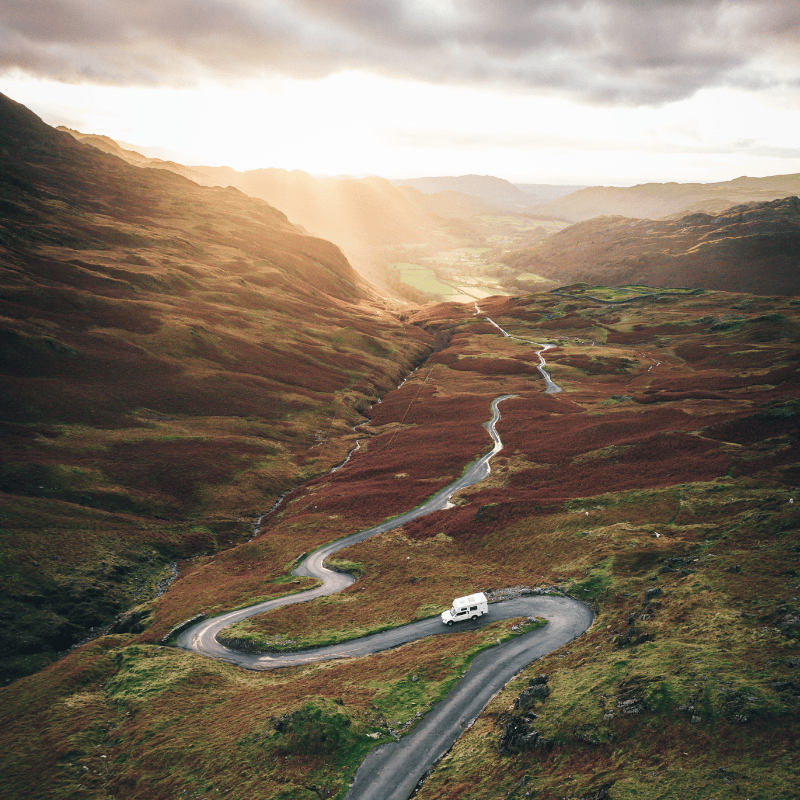Top Tips for Mountain Driving in a Motorhome

Travelling by motorhome through the Scottish Highlands or mountainous routes throughout the UK is a dream for many adventurers. But navigating steep ascents, narrow passes, and unstable weather requires a bit more care than your average road trip. Here are our top tips to keep you safe, comfortable, and confident when mountain driving in your motorhome:
1. Preparation Is Everything
Know Your Route
- Plan ahead: study elevation profiles, road gradients, width restrictions, and passing places. Some mountain roads have steep gradients of 10% or more.
- Use navigation tools tailored for larger vehicles (height/width aware route planners).
- Identify safe spots to stop or pull over if needed (laybys, viewpoints, passing places).
Check Your Vehicle
- Ensure your brakes, tyres, and suspension are in excellent condition before heading into mountainous terrain.
- Check tyre pressures: underinflated tyres heat up more on descents; overinflated tyres reduce grip.
- Be aware of weight distribution in your motorhome, heavy loads towards the rear or top can impact stability.
- Ensure all loose items inside are secured to avoid shifting weight as you go around corners.
Fuel & Fluids
- Fill your fuel tank before you climb: fuel stations may be scarce at higher altitudes.
- Make sure your coolant, oil, and other fluids are topped up; mountain driving places extra strain on engine cooling.
- Carry extra water, especially in remote areas.
2. Driving Uphill: Keep It Smooth & Steady
- Use lower gears, shifting too late can overwork the engine and risk overheating.
- Maintain a constant, moderate speed rather than fluctuating speeds; avoid aggressive acceleration.
- Don’t be afraid to let slower traffic (like cyclists) overtake safely if you’re climbing at a modest pace.
- Monitor engine temperature, if it creeps up, back off slightly, give the engine a bit of time to cool, then resume.
3. Descending Safely: Use Engine Braking
Descending in a motorhome can be more challenging than climbing. Here’s how to do it well:
- Use engine braking (low gear) rather than relying solely on your service brakes, this helps preserve your brakes and reduce fade.
- Apply the brakes gently, in pulses, rather than continuous heavy pressure.
- If going around sharp bends, reduce speed well in advance and avoid braking while turning.
- For long descents, stop occasionally (if safe) to allow brakes to cool.
- Watch for road signs indicating steep descents or hairpin curves, slow down before entering.
4. Handling Tight Corners, Hairpins & Passes
- Approach corners slowly and from the outside if visibility permits, then cut in gently.
- Use your mirrors and take the corner wide if the road allows (but avoid crossing into oncoming lanes unless it’s safe and legal).
- On very tight hairpins, you may need to “bend” your rear wheels. Be aware of overhangs and blind side obstacles.
- Always be ready to reverse carefully if you find yourself in a spot too tight (especially on narrower passes).
5. Be Mindful of Weather & Visibility
Mountain weather can change in minutes.
- Expect fog, rain, sleet, or snow, even in summer at higher altitudes, drive to conditions.
- Use dipped headlights in poor visibility, and keep your windscreen, mirrors, and lights clean.
- Watch for rockfalls, landslips or debris after heavy rain.
- Be aware of strong crosswinds in exposed passes, they can push a motorhome off balance.
6. Know When to Stop & Rest
- If you feel uneasy or the section is beyond your comfort zone, stop and reassess, especially before tackling a long descent or steep climb.
- Use laybys, scenic viewpoints, or designated parking areas to pause, check your vehicle, and take in the views.
- Ensure you remain well-hydrated and alert, fatigue affects judgment, especially in challenging driving.
7. Emergency Preparedness
You never know when you might need support:
- Carry an emergency kit: hi-vis vest, warning triangles, torch, first aid kit, basic tools.
- Have a breakdown or recovery plan (check your motorhome’s warranty or roadside cover).
- Know local emergency numbers, and if in remote areas, consider a means of communication (sat phone, beacon, or mobile signal booster).
- Let someone know your route and expected timing, especially if travelling in remote highlands.
Final Thoughts
Driving a motorhome through mountainous terrain is one of the most rewarding experiences, the views, the sense of freedom, the sense of achievement. But it demands respect, preparation, and patience.
At Dicksons of Perth, we want you to enjoy your journeys safely. Whether you’re looking to buy, service, or hire a motorhome, we’re here to support you. If there’s a particular route you want advice on, or you’d like a check-over before your trip, just get in touch.
Happy and safe travels, and may every summit be worth the climb
Dicksons of Perth, 170 Dunkeld Rd, Perth , PH1 3AA (Reg office)

Registered in Scotland No. SC20720 | Data Protection No: ZA276868
Dicksons of Perth is registered with the FCA, our registration number is 561586619.
We may receive commission or other benefits for introducing you to our finance partners.
Designed and produced by KAL Group.

